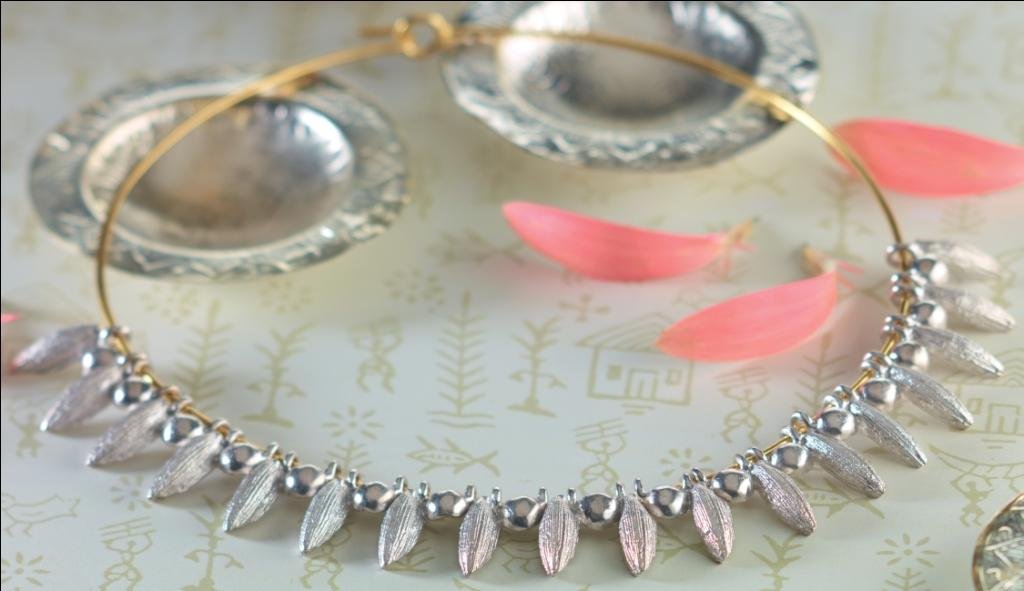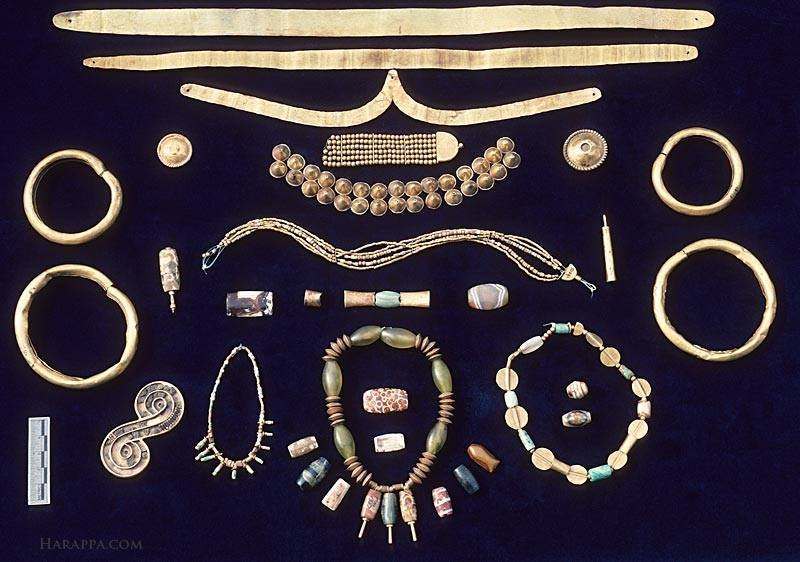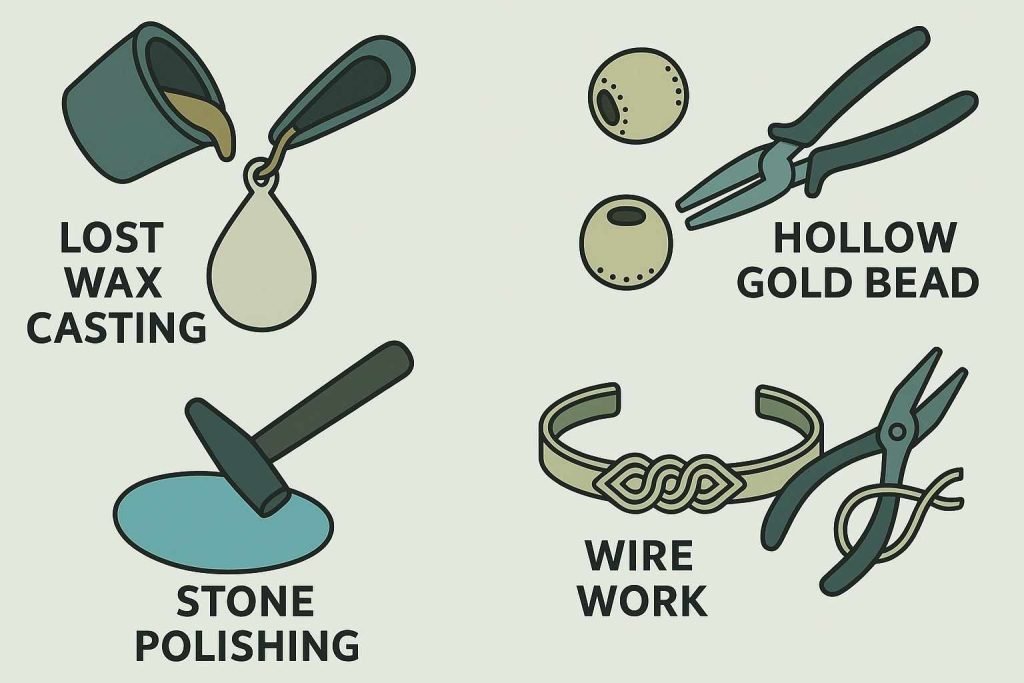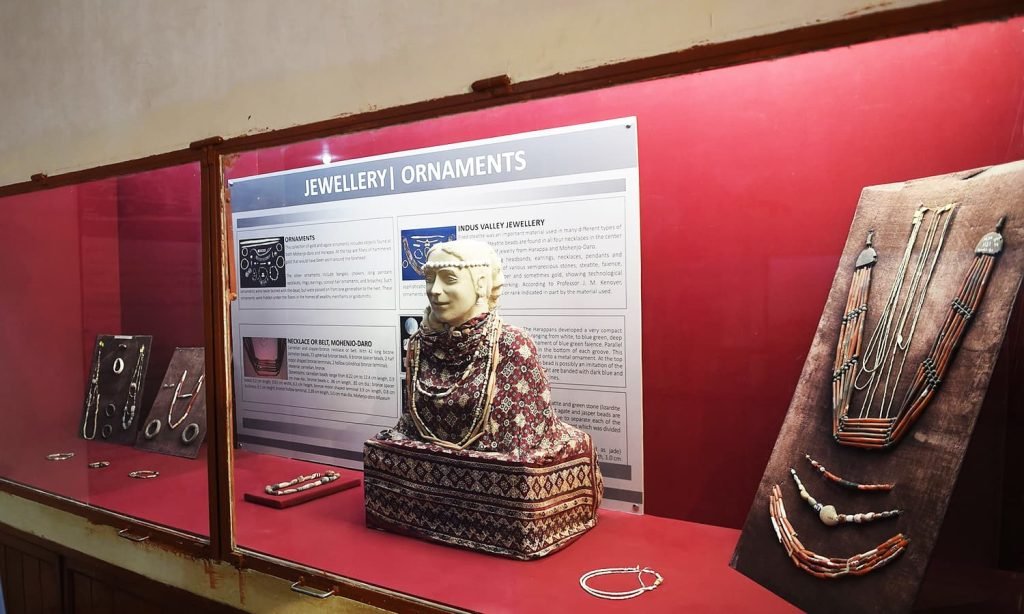Jewelry Mohenjo Daro Artifacts: Ancient Treasures Divided by Modern Borders


Jewelry Mohenjo Daro artifacts are among the most striking treasures of the Indus Valley Civilization, dating back over 4,500 years. Crafted from gold, jade, and agate, these pieces reveal extraordinary skill and cultural meaning. Today, they are also symbols of shared heritage—literally divided between India and Pakistan after 1947.
In this guide, you’ll discover how archaeologists unearthed these ancient ornaments, what makes the seven-stranded necklace so iconic, how craftsmen shaped hollow gold beads with lost-wax techniques, and where you can see these artifacts today.
Table of Contents
Discovering Jewelry Mohenjo Daro Artifacts: How the Story Begins
1920s Excavations: Jewelry Mohenjo Daro Artifacts Come to Light
The first significant finds of jewelry Mohenjo Daro artifacts emerged during excavations in the 1920s. Archaeologists uncovered beads, bangles, and intricate ornaments buried in residential areas, suggesting everyday use and ritual significance.
Marshall, Banerji & Wheeler: The Scholars Behind the Finds
Sir John Marshall and Rakhal Das Banerji led the early digs that brought global attention to Mohenjo Daro. Their work documented hundreds of ornaments—evidence that the Indus Valley people were master jewelers.
Dating Framework: Mature Harappan (c. 2600–1900 BCE)
Most jewelry Mohenjo Daro artifacts belong to the Mature Harappan period, around 2600–1900 BCE. This was the civilization’s peak, marked by urban planning, trade expansion, and flourishing craft industries.
The Seven-Stranded Showpiece: Jewelry Mohenjo Daro Artifacts that Crossed a Border


Composition & Counts: Gold, Jade, Agate — Jewelry Mohenjo Daro Artifacts in Detail
The most famous piece is the seven-stranded necklace. It originally featured 55 gold beads, 7 pendants, and jade and agate elements. Each bead was shaped with precision, showing technical mastery rare for its time.
Design Intelligence: Clasps, Hollow Gold Beads & Balance
The necklace used hollow gold beads, created by soldering two thin gold caps together—a technique known as lost-wax casting. Its design balanced weight and symmetry, proving Indus jewelers understood aesthetics and engineering.
Partition 1947: Why the Necklace Was Split Between India & Pakistan
When the subcontinent was divided, so too was the necklace. Today, half remains in the National Museum of New Delhi, India, while the other half resides in the Mohenjo Daro Museum, Pakistan.
Types & Styles: Cataloguing Jewelry Mohenjo Daro Artifacts
Necklaces, Pendants & Beadwork: From Barrel to Disc Beads
Excavations revealed strings of beads in barrel, disc, and cylindrical shapes. Many were made from semi-precious stones like carnelian, jasper, and lapis lazuli, testifying to far-reaching trade links.
Bangles, Bracelets & Armlets: Everyday Adornment to Status Markers
Bangles made of shell, copper, and even faience were discovered in abundance. Some were simple, while others bore elaborate designs, suggesting jewelry also reflected social hierarchy.
Headbands & Hair Ornaments: Ritual, Fashion, or Both?


Headpieces and hair ornaments crafted from gold and terracotta indicate that personal adornment extended beyond the body to hairstyles, possibly used in rituals or festive celebrations. Lost-wax casting A method where a wax model was covered in clay, melted away, and replaced with molten metal. Hollow bead soldering Two thin gold caps joined to create lightweight yet durable beads. Filigree work Fine metal wires twisted and soldered for decorative detailing.
How They Made It: Techniques Behind Jewelry Mohenjo Daro Artifacts


Lost-Wax Casting & Soldered Hollow Beads (Step-by-Step)
One of the most advanced methods found in jewelry Mohenjo Daro artifacts is lost-wax casting. Artisans shaped wax into bead forms, encased it in clay, then poured molten gold once the wax melted away. The result was precise, lightweight ornaments.
Stone Cutting & Polishing: Jade, Agate, Jasper, Steatite
Indus craftsmen drilled, cut, and polished hard stones with copper drills and abrasives. Jade beads from Mohenjo Daro show remarkable smoothness, while agate and jasper pendants were polished to a glassy finish.
Wire Work & Early Filigree: What the Evidence Suggests
Delicate gold wires discovered at the site point toward early filigree techniques. These fine details reinforced the idea that Indus jewelers combined strength with artistry.
Meaning & Movement: What Jewelry Mohenjo Daro Artifacts Tell Us
Social Signals: Rank, Wealth & Community Identity
Jewelry was not merely decorative. The volume and material of jewelry Mohenjo Daro artifacts suggest distinctions of social status. Wealthier citizens likely wore gold and jade, while everyday ornaments were crafted from shell or terracotta.
Belief & Symbolism: Interpreting Motifs Cautiously
Some beads and pendants may have held religious or protective meaning. Scholars warn, however, that interpretations must remain cautious, as Indus Valley script has not been fully deciphered.
Trade Networks: Materials That Traveled (and What That Implies)
The presence of lapis lazuli from Afghanistan and jade possibly from Central Asia proves Mohenjo Daro was connected to long-distance trade routes. Jewelry artifacts thus double as evidence of economic and cultural exchanges.
- Local sources: Carnelian, shell, steatite
- Regional imports: Lapis lazuli from Badakhshan
- Distant contacts: Jade and turquoise from Central Asia
Where to See Jewelry Mohenjo Daro Artifacts Today
National Museum, New Delhi: India’s Half of the Story
The National Museum in New Delhi houses a significant portion of the seven-stranded necklace. Visitors can view this centerpiece alongside other Indus Valley finds.
Mohenjo Daro Museum & National Museum Karachi: Pakistan’s Holdings
Pakistan retains many artifacts, including half of the iconic necklace, displayed at the Mohenjo Daro Museum in Sindh and the National Museum in Karachi. These institutions offer visitors a chance to witness history at its source.
International Loans & Traveling Exhibitions: How to Track Them
On occasion, jewelry Mohenjo Daro artifacts appear in international exhibitions, allowing global audiences to experience their craftsmanship. Checking UNESCO and museum announcements is the best way to stay informed.
| Artifact | Material | Date | Where to View |
|---|---|---|---|
| Seven-stranded Necklace | Gold, Jade, Agate | c. 2600–1900 BCE | New Delhi & Mohenjo Daro Museum |
| Bead Strands | Carnelian, Jasper | c. 2600 BCE | Mohenjo Daro Museum |
| Bangles | Shell, Copper, Faience | c. 2500 BCE | National Museum Karachi |
Safeguarding the Past: Conserving Jewelry Mohenjo Daro Artifacts
Site-Level Threats at Moenjodaro: Environment, Floods, Salinity
The ancient site of Mohenjo Daro faces severe environmental challenges. Seasonal floods, high groundwater salinity, and climate change pose risks not only to the ruins but also to the jewelry Mohenjo Daro artifacts preserved nearby.
Object-Level Care: Metals vs. Stone—Different Preservation Playbooks
Gold is resistant to corrosion, but hollow beads and soldered joints remain fragile. Stones like jade and agate require stable humidity levels to avoid cracking. Curators carefully regulate temperature and lighting to slow deterioration.
UNESCO Protection & Ongoing Research: What’s Working, What’s Next
Since its designation as a UNESCO World Heritage Site in 1980, Mohenjo Daro has benefited from international collaboration. Preservation workshops and 3D scanning projects are helping create long-term conservation strategies.


Modern Echoes: How Jewelry Mohenjo Daro Artifacts Inspire Today
Design Influences: Translating Ancient Forms into Contemporary Pieces
Contemporary jewelers often draw inspiration from Indus Valley motifs. Disc-shaped beads, wire filigree, and multi-stranded necklaces are still echoed in modern South Asian jewelry collections.
Museum-Guided Learning: Study Resources & 3D/Virtual Access
Virtual museum tours and 3D scans now allow students and enthusiasts worldwide to study jewelry Mohenjo Daro artifacts in detail without traveling, expanding accessibility to heritage education.
Ethics & Heritage: Why “Artifacts for Sale” Is a Red Flag
Occasionally, misleading online listings suggest Indus artifacts are available for sale. Authentic jewelry pieces are protected cultural heritage and cannot be legally traded. Any such claims should be approached with caution.
FAQ: Quick Answers About Jewelry Mohenjo Daro Artifacts
What are the most famous jewelry Mohenjo Daro artifacts?
The seven-stranded necklace, bead strands of carnelian, and shell bangles are among the most famous discoveries.
How old are jewelry Mohenjo Daro artifacts, and how are they dated?
They date back to the Mature Harappan period, roughly 2600–1900 BCE, confirmed through stratigraphy and comparative analysis.
What materials dominate jewelry Mohenjo Daro artifacts?
Gold, jade, agate, jasper, carnelian, shell, copper, and faience are the most common materials used.
Why is the seven-stranded necklace from Mohenjo Daro split between two countries?
After the 1947 Partition, the necklace was physically divided, with halves kept in India and Pakistan to represent shared heritage.
Where can I see jewelry Mohenjo Daro artifacts today?
Key artifacts are housed in the National Museum, New Delhi; Mohenjo Daro Museum, Sindh; and the National Museum, Karachi.
How were jewelry Mohenjo Daro artifacts manufactured (lost-wax, hollow beads)?
Craftsmen used lost-wax casting for gold pieces, soldering for hollow beads, and advanced stone polishing for jade and agate ornaments.
What do jewelry Mohenjo Daro artifacts reveal about Indus trade and society?
The wide variety of materials, many imported, proves extensive trade networks and shows jewelry as a marker of wealth and cultural identity.
Conclusion: Why Jewelry Mohenjo Daro Artifacts Still Matter
The jewelry Mohenjo Daro artifacts are more than ornamental remains of a vanished civilization. They embody advanced craftsmanship, reveal long-distance trade routes, and highlight cultural practices that united ancient communities. Their division between India and Pakistan after Partition adds a poignant modern chapter to their 4,500-year-old story.
- They prove the Indus Valley people mastered goldsmithing and stonework.
- They reflect social and spiritual meanings beyond decoration.
- They remind us of heritage preservation amid environmental threats.
About the Author
Author: ZunNurain Khalid — Travel & Tourism Specialist, Founder of ExploreX Pvt. Ltd., and advocate for sustainable tourism in Pakistan. With over a decade of experience in digital marketing and destination branding, ZunNurain has worked extensively on promoting Pakistan’s natural and cultural heritage.

